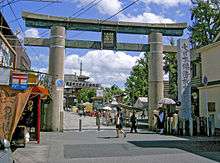Shitennō-ji
| Arahakasan Shitennō-ji | |
|---|---|
|
Chushin garan (中心伽藍) | |
| Basic information | |
| Location | 1-1-18 Shitennō-ji, Tennōji-ku, Osaka, Osaka-fu |
| Affiliation | Wa-shū |
| Deity | Kannon (Avalokiteśvara) |
| Country | Japan |
| Website | http://www.shitennoji.or.jp/ |
| Architectural description | |
| Founder | Prince Shōtoku |
| Completed | 593 |
Coordinates: 34°39′14.04″N 135°30′59.22″E / 34.6539000°N 135.5164500°E Shitennō-ji (Japanese: 四天王寺; also Arahaka-ji, Nanba-ji, or Mitsu-ji) is a Buddhist temple in Ōsaka, Japan. It is sometimes regarded as the first Buddhist and oldest officially administered temple in Japan,[1][2] although the temple buildings have been rebuilt over the centuries.
History
Prince Shōtoku invited three Korean Baekje carpenters, and they constructed this temple in 593. Prince Shōtoku was known for his profound Buddhist faith when Buddhism was not widespread in Japan. [3] Most of the present structures are from when the temple was last completely rebuilt in 1963. One of the members involved in the initial construction of the temple in the 6th century later established a firm Kongō Gumi, specialized in temple and shrine buildings over centuries.

Description
The Shitennō are believed to be four heavenly kings. The temple Prince Shōtoku built to honor them had four institutions, each to help the Japanese attain a higher level of civilization. This Shika-in (四箇院 Four Institutions) was centered on the seven-building garan (伽藍) (the complex inside the walls), and included a Kyōden-in (Institution of Religion and Education), a Hiden-in (welfare Institution), a Ryōbyō-in (hospital), and a Seiyaku-in (pharmacy) to provide essential care to the people of Japan.[4]
The garan consists of a five-story pagoda, a main Golden Pavilion (Kondō) housing an image of the Nyorai Kannon, and a Kōdō (Lecture Hall) under a covered corridor holding three gates (the Deva Gate,[5] the Western Gate, and the Eastern Gate). Surrounding this central complex are the Great South Gate (Nandaimon), and a Great East Gate (Higashi-no-ō'mon). To the west is the Great West Gate (Nishi-no-ō'mon), also known as Gokuraku-mon (極楽門). Further to the west is a stone torii, which is widely accepted as the Eastern Gate to the gokuraku-jōdo (極楽浄土 Western Paradise, or the Pure Land).
Shitennō-ji sells some souvenirs of their products on the 21st of each month.
Access
- a 5-minute walk from Shitennoji-mae Yuhigaoka Station on the Osaka Municipal Subway Tanimachi Line.
- a 15-minute walk from Tennoji Station on the JR West Lines and the Osaka Municipal Subway Lines.
- a 15-minute walk from Osaka Abenobashi Station on the Kintetsu Minami-Osaka Line.
Images
 Kondō
Kondō the Great West Gate (Gokuraku-mon)
the Great West Gate (Gokuraku-mon) the Great East Gate
the Great East Gate the Great South Gate (Nandai-mon)
the Great South Gate (Nandai-mon) Northern belfry
Northern belfry Southern belfry
Southern belfry Stone torii
Stone torii Courtyard
Courtyard Niō
Niō Niō
Niō Statuettes of Kūkai
Statuettes of Kūkai
See also
- For an explanation of terms concerning Japanese Buddhism, Japanese Buddhist art, and Japanese Buddhist temple architecture, see the Glossary of Japanese Buddhism.
- List of National Treasures of Japan (archaeological materials)
- List of National Treasures of Japan (crafts: others)
- List of National Treasures of Japan (crafts: swords)
- List of National Treasures of Japan (paintings)
- List of National Treasures of Japan (writings)
- Thirteen Buddhist Sites of Osaka
- Historical Sites of Prince Shōtoku
References
- ↑ Scheid, Bernhard. "Religion in Japan". Torii (in German). University of Vienna. Retrieved 12 February 2010.
- ↑ "Asuka-Dera Temple". Retrieved 29 September 2016.
- ↑ "World's oldest company, started by Koreans, goes kaput : International : News : The Hankyoreh". Hani.co.kr. 2006-08-12. Retrieved 2015-08-25.
- ↑ Three of the four sections are known to have existed inside the temple in Kamakura period.
- ↑ Niōmon (仁王門), also called chūmon (中門).
External links
| Wikimedia Commons has media related to Shitennoji. |
